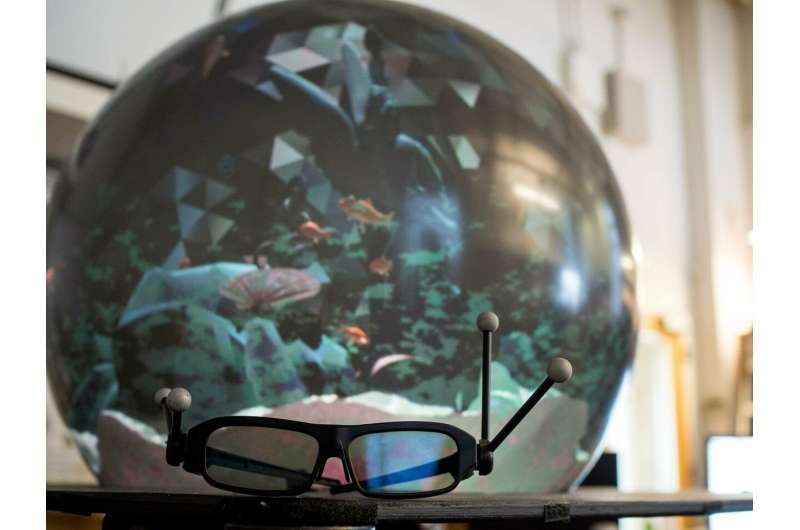Virtual reality spherical display Credit: Clare Kiernan, UBC
Virtual reality can often make a user feel isolated from the world, with only computer-generated characters for company. But researchers at the University of British Columbia and University of Saskatchewan think they may have found a way to encourage a more sociable virtual reality.
The researchers have developed a ball-shaped VR display that supports up to two users at a time, using advanced calibration and graphics rendering techniques that produce a complete, distortion-free 3-D image even when viewed from multiple angles.
Most spherical VR displays in the market are capable of showing a correct image only from a single viewpoint, said lead researcher Sidney Fels, an electrical and computer engineering professor at UBC.
"When you look at our globe, the 3-D illusion is rich and correct from any angle," explained Fels. "This allows two users to use the display to do some sort of collaborative task or enjoy a multiplayer game, while being in the same space. It's one of the very first spherical VR systems with this capability."
The system, which the researchers are calling Crystal, includes a 24-inch (600 millimetre) hollow ball-shaped display. The display surface was custom-made to specifications in Ottawa, while four high-speed projectors and one camera used for creating the images, calibration and touch sensing were purchased off-the-shelf.
University of British Columbia professor Sid Fels explains how a globe VR display supports two or more players Credit: Clare Kiernan, UBC
The researchers are working on a four-person system and see many potential uses for their display in the future, including multiplayer virtual reality games, virtual surgery and VR-aided learning. However, they are focusing on teleconferencing applications and computer-aided design for now.
"Imagine a remote user joining a meeting of local users. At either location you can have a Crystal globe, which is great for seeing people's heads and faces in 3-D," said Ian Stavness, a computer science professor at the University of Saskatchewan and a member of the research team. "Or you can have a team of industrial designers in a room, perfecting a design with the help of VR and motion tracking technology."
While the technology is young, the researchers are forecasting a good future for it.
"We're not saying that spherical VR will replace flat screens or headsets," said Fels, adding "but we think it can be a good option for VR activities where you still want to see and talk to other people—be it at home or in the office, for work or play."
More information: Dylan Brodie Fafard et al. Design and implementation of a multi-person fish-tank virtual reality display, Proceedings of the 24th ACM Symposium on Virtual Reality Software and Technology - VRST '18 (2018). DOI: 10.1145/3281505.3281540
Provided by University of British Columbia
























